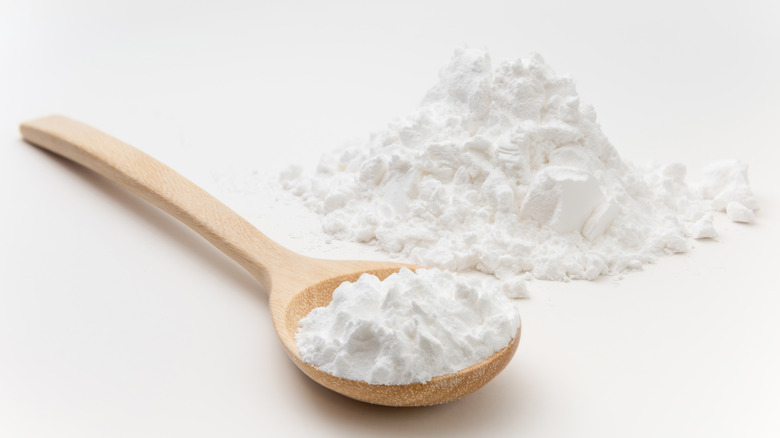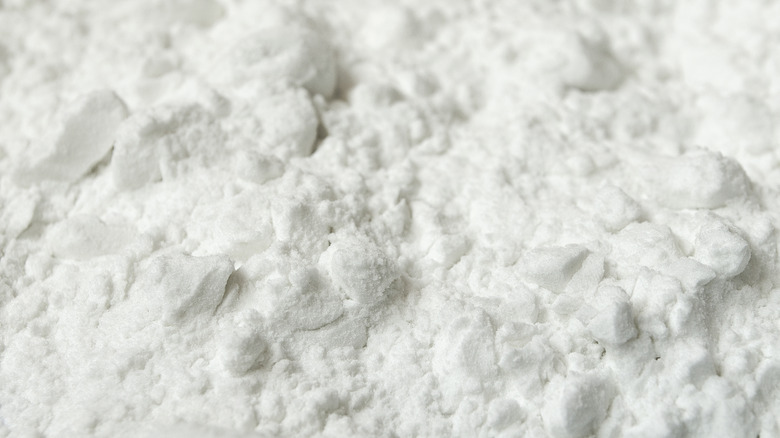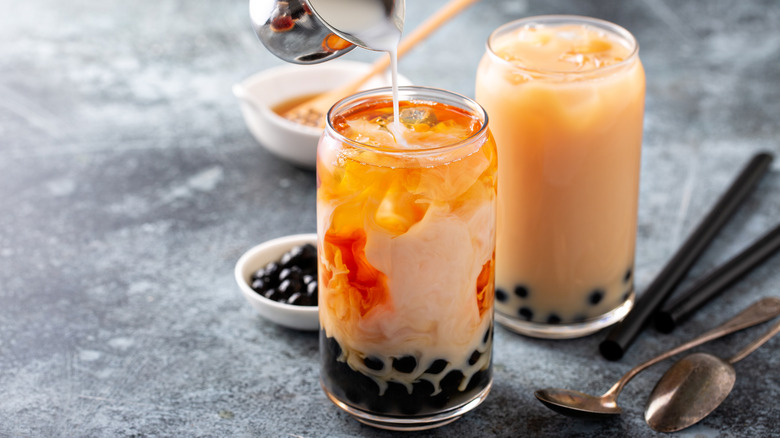Here's Where You Can Find Tapioca For Baking Or Boba
Tapioca is a versatile ingredient commonly used in various dishes, from baked goods to soups and stews. For the uninitiated, tapioca is a starchy substance that is derived from the roots of the cassava plant. Originally from South America, cassava is now grown worldwide, and it's harvested and then processed into different forms of tapioca, including flour, flakes, and pearls.
Tapioca flour is made by soaking and wringing cassava pulp. Once the starch has been extracted, tapioca flakes can be made by flattening small pieces of tapioca dough into flakes and partially cooking them. Tapioca pearls are made by adding water to tapioca starch forming a dough which is then shaped into small balls. These pearls are then boiled in water with brown sugar and used in various desserts, including boba tea, while the flour and flakes are used as thickeners in soups and stews or as a gluten-free alternative to wheat flour in baking.
While all of these forms of tapioca are readily available to home cooks, you might not know exactly how each is used or where to buy them so let's explore their differences more closely and where you can get your hands on each tapioca type.
How to use tapioca flour
Tapioca flour, also known as tapioca starch, is a fine, white powder that is commonly used in gluten-free baking. Because tapioca is a starch rather than a grain such as wheat or rye, it does not form gluten as it is worked into a dough or batter so it's a good alternative for people with gluten allergies or Celiac disease. It is also a great alternative to typical flour because it has a neutral flavor and a light, fluffy texture that makes it a great addition to baked goods. You'll often find tapioca flour in gluten-free cakes, cookies, bread, and even pizza crust.
When using tapioca flour in baking, it is important to note that it is very absorbent and can make your baked goods thick and chewy if you use too much, so use a light touch as you first begin experimenting with this ingredient. However, tapioca flour can keep baked goods from becoming too dry thanks to this quality. As such, it is best to follow recipes that are specifically designed for tapioca flour rather than swapping the starch into recipes that call for standard flour.
Thanks to its versatility in baking and cooking, tapioca starch is widely available in grocery stores and supermarkets. You should find it in the baking aisle usually alongside other alternative flours or containers of corn and potato starch. You can also visit your local Asian market, which should also have it on hand.
How to use tapioca pearls
Tapioca pearls are used in the popular Taiwanese drink, boba tea, and are also used in desserts and puddings. These small, chewy pearls are made by adding water to tapioca starch to form a dough, which is then shaped into small balls. The tapioca balls are usually sold in a dried form and need to be cooked before they can be used in recipes.
To cook tapioca pearls, bring a large pot of water to a boil and add the pearls. Let them cook for 10 to 15 minutes until they are soft and chewy then drain and rinse them with cold water to stop the cooking process. They can then be used in a variety of recipes — often desserts or sweets — or stored in the refrigerator for up to a week.
Dried tapioca pearls are likely available at your local grocery store or Asian supermarket, but if you can't find pre-made tapioca balls, don't worry! You can make your own by mixing tapioca starch with water until it forms a dough. If you prefer, you can add sugar to the mixture too. From there, shape the dough into small balls and let them dry out for a few hours. Once they are dry, store or cook them as you would pre-made tapioca pearls. This method takes a bit more time, but it is a great way to ensure that you have fresh, homemade tapioca pearls for your boba tea or other recipes.
How to use tapioca flakes
Tapioca flakes are used as a thickener in soups, stews, and even pie fillings. Tapioca flakes have a similar texture to instant oatmeal and dissolve quickly when added to hot liquids. They are a great alternative to flour or cornstarch as a thickener, as they do not leave a starchy taste or cloudiness in your dish. When using tapioca flakes as a thickener, it is important to sprinkle them over the hot liquid or mixture and whisk them in quickly to prevent clumping.
Tapioca flakes are less ubiquitous than tapioca pearls or flour but, they are likely available at your local grocery store in the baking aisle. If for some reason you cannot find the type of tapioca you need at your grocery store, you can always turn to the internet. From Amazon to specialized tapioca websites, you can find exactly what you are looking for.
So next time you are at the grocery store, be sure to pick up some tapioca for whatever your cooking needs may be. Even if you do not plan to use tapioca flour or tapioca products beyond a few recipes, you might be surprised at just how handy the starchy thickening agent can be.



